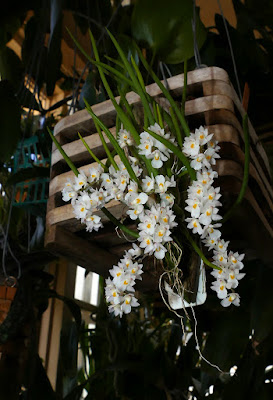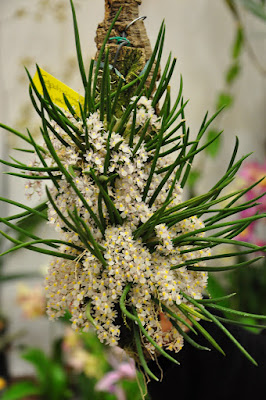Capanemia uliginosa is native to Brazil. These orchids were found in the states of Minas Gerais and Rio de Janeiro near Campos, and in several other places. They grow on trees in rain forests on trees near streams...
Capanemia uliginosa also called as The Swamp Dwelling Capanemia, Rodriguezia uliginosa, is a species of the genus Capanemia. This species was described by João Barbosa Rodrigues in 1881.
IDENTIFY CAPANEMIA ULIGINOSA
Capanemia uliginosa is native to Brazil. These orchids were found in the states of Minas Gerais and Rio de Janeiro near Campos, and in several other places. They grow on trees in rain forests on trees near streams.
It is a miniature sized, warm to cool growing epiphyte, which reaching 6.5-9.9 cm in height, with minute, linear-oblong, slightly laterally compressed, smooth in youth and longitudinally sulcate with age, 1.5-2.5 cm long and 0.3-0.5 cm wide pseudobulbs enveloped basally by a few membranous, narrowly triangular, scarious, acute sheaths carrying a single, apical, erect to ascending, terete, bright green, slightly coriaceous, stiff, curved, channeled above, acute, 5-7 cm long and 0.25-0.3 cm wide leaf.
The Swamp Dwelling Capanemia blooms in the spring on a basal, pendant to ascending, slender, thread-like, several to many flowered inflorescence. The flowers are up to 1 cm long, white with a yellow crest on the lip and have a pink spot at the base of the spine. The outer whorls are membranous, broadly roundish, and their tips are sharp. The dorsal petal is opens at the base but curves inward at the apex. The obliquely distributed side flakes have bumps on the underside and are slightly extended at the base. The internal whorls are rather ovate, slightly oblique, slightly concave, pointed, slightly gently 3-stranded and have almost the same length as the dorsal petal. Triangular to egg-shaped lip is thin and membranous, hairy at the base and smooth towards the apex. The base is broadly wedged, but has a rounded top and smooth edges. The oblong thickening is short, fleshy and clearly raised. The short, wide rod is smooth and has a small pair of ear-like appendages at the apex.
CAPANEMIA ULIGINOSA CARE AND CULTURE
Cultural information should only be used as a guide, and should be to be adapted to suit you. Your physical location; where you grow your plants, how much time you have to devote to their care, and many other factors, will need to be taken into account. Only then can you decide on the cultural methods that best suit you and your plants.
Light:
Capanemia uliginosa needs a light level of 20000-35000 lux. The plants grow best in bright, but slightly diffused light and need protection from direct southern sun.
Temperature:
It is a thermophilic plant. The average temperature of the summer day is 27-29 ° C, night 18-19 ° C, which gives a daily difference of 9-10 ° C. The average temperature of the winter day is 23-24 ° C, the night 13-14 ° C, giving a daily difference of 10-11 ° C.
Humidity:
The Swamp Dwelling Capanemia needs the humidity of 80-85% throughout the year.
Substrate, growing media and repotting:
You can use any loose medium gradation, but the plant grows better on washers.
Watering:
In natural habitat, rainfall is moderate to heavy from late spring to autumn. Then their number drops and a drier winter starts. Capanemia uliginosa should often be watered during the growing season, but it must be perfect drainage and the roots must dry fast after watering. In the late autumn, when the young growths mature, the amount of water should be slightly reduced.
Fertilizer:
During the active growth, the plants should be fertilized every week 1/4-1/2 of the recommended dose of fertilizer for orchids. A fertilizer with a high nitrogen content is beneficial from spring to mid-summer, and a fertilizer richer in phosphorus should be used in late summer and autumn.
Rest period:
In winter, Capanemia uliginosa need less water, but they should never dry up completely. Fertilization should be reduced or eliminated until new growths appear in the spring and regular watering starts.















COMMENTS